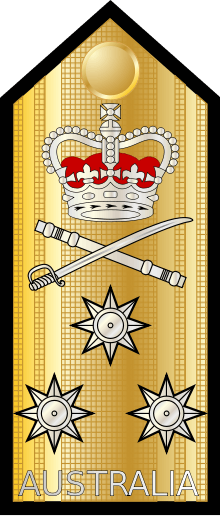Vice admiral (Australia)

- See vice admiral for other countries that use this rank
Vice admiral (VADM) is the second-highest active rank of the Royal Australian Navy and was created as a direct equivalent of the British rank of vice admiral. It is a three-star rank. The rank is held by the Chief of Navy and, when the positions are held by navy officers, by the Vice Chief of the Defence Force, the Chief of Joint Operations, or the Chief of the Capability Development Executive.
Vice admiral is a higher rank than rear admiral, but lower than admiral. Vice admiral is the equivalent of air marshal in the Royal Australian Air Force and lieutenant general in the Australian Army. Since the mid-1990s, the insignia of a Royal Australian Navy Vice Admiral is the crown of St. Edward above a crossed sabre[1] and baton, above three silver stars, above the word "AUSTRALIA". The stars have eight points[2] as in the equivalent Royal Navy insignia. Prior to 1995, the RAN shoulder board was identical to the UK shoulder board. (The UK shoulder board changed in 2001.)
Australian Vice Admirals
A list of navy officers who held the position of Chief of Navy as a Vice Admiral can be found here.
Navy officers who have held the rank of Vice Admiral via other paths:
- Sir William Rooke Creswell (Promoted to Vice Admiral in 1922 after his retirement from the RAN)
- Ian Knox (VCDF January 1987 – September 1989)
- Alan Beaumont (VCDF September 1989 – October 1992)
- Robert Walls (VCDF April 1995 – March 1997)
- Chris Barrie (VCDF March 1997 – July 1998)
- Matt Tripovich (Chief of the Capability Development Executive July 2007 – 2010)
- Peter Jones (Chief of the Capability Development Executive November 2011 - Present)
See also
- Australian Defence Force ranks and insignia
Notes
- ↑ Usually in Commonwealth countries a scimitar is used in the insignia, which is an open-handled weapon; the sabre has a closed handle.
- ↑ The stars have eight points, unlike the four pointed Order of the Bath stars used by the army (which are often referred to as "pips".)
| ||||||||||||||||||||